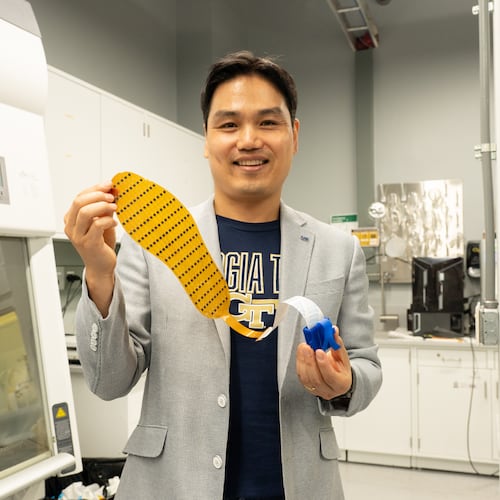That hamster on his wheel might have been onto something.
A new study from Australia found that running workouts that include sprinting can help older people stay mentally fit longer. But experts say summoning the motivation to start is usually the biggest barrier facing seniors in Georgia and elsewhere.
Their study grew out of a body of evidence suggesting that the brain can produce new neurons or brain cells even later in life. High-intensity exercise appears to be a way to kick-start that process.
The study was conducted at the University of Queensland Brain Institute by Perry Bartlett and Daniel Blackmore and was based on an earlier test in rodents that showed promising results. The researchers enlisted 150 volunteers ages 65 to 85 and created customized High Intensity Interval Training running workouts for one group, stretching workouts for a second group and brisk walking regimens for a third group.
A HIIT running workout alternates intervals of extreme effort or sprints alternating with periods of easier efforts or jogs. The participants who ran intervals on treadmills three times a week for six months saw cognitive improvements that lasted at least five years — even if they stopped the sprinting workouts.
Blackmore told The Atlanta Journal-Constitution he and his team had a hunch that their earlier work prodding rodents to run might yield similar results in humans.
“We showed in rodent work that the hippocampus, which is a part of the brain important for spatial learning, could create new neurons through exercise,” Blackmore said.
Neurons are nerve cells found in the brain and nervous system that send commands to muscles and relay electrical signals. While for decades many thought that it was impossible to develop new neurons after infancy, more recent studies have shown it is possible via “neural stem cells.”
“Whenever we talked about stem cells, people thought about embryonic stem cells,” Blackmore said. “But we now know that the brain can develop new stem cells, even late in life. It’s not necessarily a downward trajectory, and we’ve shown that. Six months of high-intensity interval training is enough to flick the switch.”
The team found that the act of running intensively led to changes in circulating levels of a molecule known as brain-derived neurotrophic factor and cortisol, the body’s primary stress hormone. This, in turn, correlated to improved cognitive ability.
Brain-derived neurotrophic factor stimulates and controls growth of new neurons from neural stem cells. BDNF is a key component of brain plasticity, which is essential for learning and memory. Studies in aged rats and rhesus monkeys have found that BDNF gene therapy prevented the death of cells in the brain and led to improvements in memory, according to UC San Diego.
Low levels of BDNF are associated with neurodegenerative diseases with neuronal loss, such as Parkinson’s disease, Alzheimer’s disease, multiple sclerosis and Huntington’s disease.
The fact that simply running could boost memory is a novel finding, said Dr. Theodore M. Johnson II, chair for Emory’s Department of Family and Preventive Medicine.
“This survey showed that low-interval training doesn’t show the same benefit as HIIT — that’s a new message,” Johnson said.
The participants’ primary care physicians signed off on the participants having relatively healthy hearts. The HIIT group reached 85-95% of their maximum heart rates during four rounds of running per 25-minute session on an inclined treadmill. The researchers measured progress via blood tests and MRI imaging.
Johnson said Georgians should also check with their doctors first before starting HIIT workouts. But if you get the signoff, “it’s a way to get more bang for your exercise half hour.” Emory Decatur Hospital Wellness Center can help Atlantans create similar, customized exercise programs, he added.
The exercise regime in the Australian study’s HIIT group was more intensive than the CDC’s recommendation that people get at least 150 minutes a week of moderate exercise.
For people who are interested in preserving brain health, HIIT could be paired dietary and lifestyle changes aimed at preventing stroke, diabetes and tooth decay — all of which have been linked to dementia.
It might even be most beneficial to start sprinting in middle age, said Marissa Gogniat of the Vanderbilt Memory and Alzheimer’s Center. “By the time you’re an older adult, these biological processes have been cooking for a long time. So midlife, or even younger, might be the time to integrate this.”
But the biggest barrier is often finding a friend or community to work with, Gogniat said. “I recommend the buddy system — if you engage in physical activity with someone else, you’re more likely to follow through. And when you get out there, it will feel good and you will want to continue.”
L. Stephen Miller, an emeritus professor at the University of Georgia who ran the Neuropsychology and Memory Assessment Laboratory, says those hoping to boost their cognitive abilities can start small. “You can park 15 minutes away from the restaurant and then walk there and back — that really helps,” he said. He also recommends dancing, not just because it’s fun “but because it forces you to pay attention to many things cognitively.”
He does his HIIT workouts in the pool, during hourlong swims that burn roughly 1,000 calories per workout. And if that’s not possible for everyone, less is also ok. “Any physical activity is good, and more is better, usually, even if that means just walking around the block or walking up and down the stairs at home,” Miller said.
That was one of the study’s other takeaways: that exercise is just one part of cognitive health, which includes staying social at an older age.
Kennesaw resident Jamie Vann, 78, said he had been a member of several gyms but lacked the motivation to train on his own. “I needed an accountability partner — a trainer in my case, but it can be a friend,” he said. His wife, Mikel Vann, 79, also takes part. Though she doesn’t run, she said her three weekly aerobic and weight workouts have become a social activity.
“I think it’s very important for senior women to do this,” she said. “It’s therapeutic to be there with friends — we giggle and laugh. I’ve been doing it for five years and have come a long way with my balance.”
Blackmore said the study’s exercise physiologists and the participants became almost a sort of community who cheered each other on, creating a social structure for the older participants in the program.
“We showed that people can generate new neurons, but you have to put those neurons to work — from crosswords to social interactions,” he added.
Editor’s note: This story was updated Sept. 3 to correct the title of Dr. Theodore M. Johnson II, chair for Emory’s Department of Family and Preventive Medicine.
About the Author
Keep Reading
The Latest
Featured

